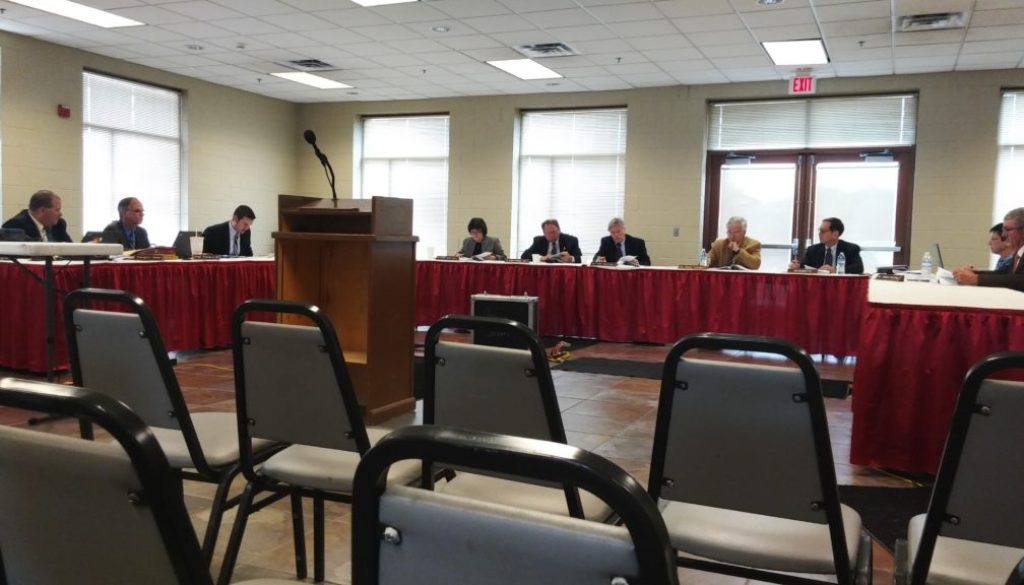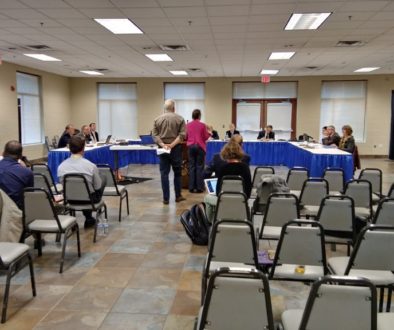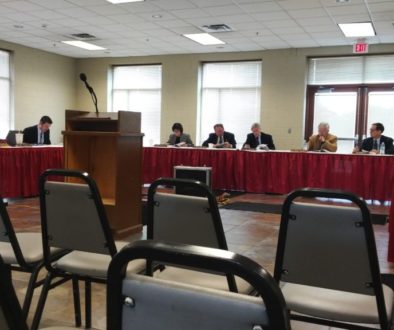NC Pesticide Board Meeting – May 10, 2016 – Progress
Board members present: Dr. Colleen Hudak-Wise, Dr. Ricky Langley (Chair), Dr. Thomas Scarborough (Vice-Chair), Shawn Harding, Don Rodgers, Dr. W. Benson Kirkman
The NC Pesticide Board met on May 10th, 2016 with an extremely full agenda of settlement agreements. The Board’s new legal counsel, Christopher McLennan, has made it a priority to catch up on settlement agreements, as there was a backup due to paralegal troubles within the Department of Agriculture. There were 23 settlement agreements for a total of $33,800 in penalties that were up for approval from the Board, with all of them being approved unanimously. Please see link below for description of violation, violator, and settlement amount.
Before the Board moved into the settlement agreements, Toxic Free NC’s Policy Advocate, Preston Peck, had an opportunity to give a presentation to the Board entitled, “The state of the science of neonicotinoid insecticides and effects on aquatic invertebrates.” This presentation gave a review of “Neonicotinoid contamination of global surface waters and associated risk to aquatic invertebrates: A review” by Morrissey et. al. and related it back to water contamination issues in North Carolina. The Board was quite receptive to this presentation and voted unanimously to inquire into NC Department of Environmental Quality’s Random Ambient Monitoring System (RAMS) about if they are monitoring for neonicotinoid insecticides and, if so, what levels they are finding. If the RAMS program is not monitoring for neonicotinoids, then the Board admitted that testing should be conducted through a commissioned study. The results of the inquiry are to be reported back at the next Board meeting. Please see full speech below.
“The state of the science of neonicotinoid insecticides and effects on aquatic invertebrates.” Preston Peck, Policy Advocate, Toxic Free NC
Thank you for the opportunity to bring these important issues concerning pesticide contamination to the Board’s attention. What you have in front of you is a comprehensive review by Morrissey et al. of 29 published studies from nine countries on the acute and chronic toxicity to 49 species of aquatic insects and crustaceans spanning 12 invertebrate orders. These studies are from the academic sector, industry sector, and various government regulatory entities. The findings in the study are consistent with what I have brought forward to the Board previously, in that, the thresholds set for water contamination of neonicotinoids by regulatory agencies a vastly under representative of the levels that can lead to both short and long-term impacts on aquatic invertebrate species. Furthermore, consistent with Center for Food Safety’s report, Water Hazard, the majority of studies reviewed used Daphnia magna as their test species for neonicotinoids. This information could contribute to the regulatory agencies setting the threshold extremely high for neonicotinoid exposure as D. magna seems to be the industry’s preferred test species but also has an extremely high tolerance for neonicotinoid exposure at a half maximal effective concentration (EC50) range of 4100 to 1,000,000 mg/L, with a geometric mean of 43,927 mg/L. By contrast, the mayfly, caddisfly, and midge are about 100,000 times more sensitive to neonicotinoids, have acute toxicity levels that average below EPA standardized thresholds for neonicotinoids, and are critical to supporting aquatic and terrestrial food webs. The overreliance on D. magna, that has an extremely high tolerance for these chemicals, can, and potentially has, lead to an inadequate determination of levels that impact aquatic invertebrates by both state and federal regulatory agencies.
Furthermore, in light of the Board’s previous comments concerning water sampling in North Carolina and that the levels found of specifically, imidacloprid, were well below the thresholds set forth by the EPA, I reached out to the NC Division of Water Resources to ask about sampling methodology. After speaking with Brian Pointer, Ambient Monitoring System Coordinator within the Division, I found out several things about the sampling methodology that concerned me that the true exposure rates are not being adequately represented. In his words, “RAMS are sampled monthly (not based on weather/streamflow – again, the random nature of the sampling), but pesticides are sampled every other month in addition to SVOCs and a couple of other parameters. RAMS are sampled on a two year cycle, are always freshwater stream sites, and the sites are chosen at random from a grid that is provided us by EPA. They are occasionally near urban and agricultural activities, but they are not purposely targeted at those locations due to the random nature of site selection. Generally, these sites are very small streams, but we do have a couple of large rivers occasionally (e.g., NE Cape Fear in this current cycle).”
This was concerning for a variety of reasons in relation to pesticide water contamination. First, it is troubling to know that pesticide contamination sampling occurs only six times a year by the Division, and not necessarily in areas that have heavy agricultural production. While, I understand the benefits and scientific significance of randomized sampling, there could be effort to strategically obtain random samples for a general region, so that we can obtain data that accurately reflects pesticide contamination for both high and low agricultural production areas. Also, it was troubling to hear that samples are not taken at peak flows following rain, and other events that would more adequately reflect the real toxicity thresholds that these species face. Given this information of sampling methodology, there seems to be a gap in knowledge of perceived pesticide contamination levels and realistic contamination levels.
Under the Pesticide Law of 1971, section 143-437, part 2, the Board has the duty “to carry out a planning, environmental and biological monitoring, and investigation into long-rage needs and problems concerning pesticides.” That being said, the evidence of water contamination by neonicotinoid insecticides is well documented at levels that, at the very least, are disruptive to aquatic ecosystems and the Board should therefore commission a study to investigate the level of contamination around North Carolina at peak flow times in areas where there is heavy neonicotinoid use as to accurately estimate maximum threshold exposure levels for both aquatic invertebrate species and other species that might consume contaminated water. It is also within the purview of the Board, under section 143-440, Part (a) that the Board “may designate any pesticide or device as a ‘restricted use pesticide’ upon the grounds that, in the judgment of the Board (either because of its persistence, its toxicity, or otherwise) it is so hazardous or injurious to persons, pollinating insects, animals, crops, wildlife, or the environment, other than the pests it is intended to prevent, destroy, control, or mitigate that additional restriction on its sale, purpose, use or possession are required.”
It is the recommendation of Toxic Free NC that the Board commission a study to specifically examine neonicotinoids pervasiveness in North Carolina’s soil and water, then, contingent upon the findings and public input, restrict the application and sale of neonicotinoids as the Board sees appropriate. I hope that the Board strongly considers these recommendations and takes the pervasiveness of these chemicals seriously as more articles come out everyday demonstrating how pervasive these chemicals continue to be in our environment.
Preston H. Peck, Policy Advocate
Toxic Free NC
Settlement Agreements for Violations of Pesticide Law
N.C. Department of Agriculture and Consumer Services, Structural Pest Control and Pesticide Division v.




